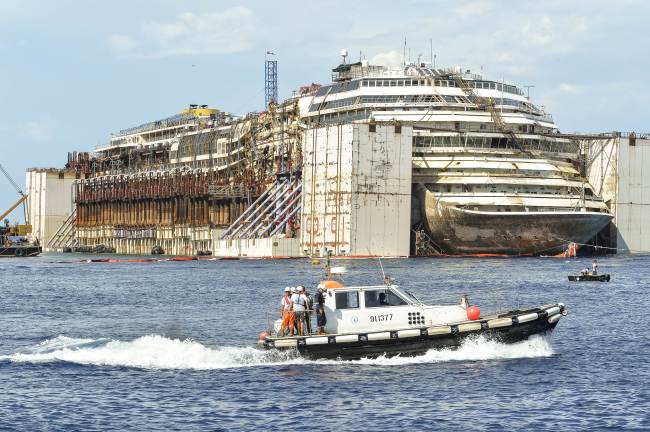GIGLIO ISLAND, Italy (AFP) ― Italy’s Costa Concordia will set sail on its final voyage Wednesday as survivors look on, two and a half years after the luxury cruise ship crashed and sank in a nighttime disaster that left 32 people dead.
The rusting liner, which has been floated from its watery grave in the biggest salvage operation of a passenger ship ever performed, will be towed away to the port of Genoa in northwest Italy to be dismantled and scrapped.
Surviving passengers who have returned to Tuscany’s Giglio Island will gather with locals and holidaymakers to bid a final farewell to the once-magnificent cruise ship.
“We hope that many of our feelings (from the night of the disaster) will leave when the boat leaves. And that as it goes on its way, we can finally go on ours,” said Anne Decre from the French Survivors’ Collective, as she clutched the hand of friend Nicole Servel, whose husband died in the disaster.

The wreck of the Costa Concordia cruise ship is seen in front of the harbor of Isola del Giglio, after it was refloated using air tanks attached to its sides off Giglio Island, Italy, Tuesday. (AFP-Yonhap)
The ship ― roughly twice the size of the Titanic ― will be dragged up the Corsica channel by two tug boats at a speed of just 3.7 kilometers per hour, and is expected to reach Genoa in four days, weather permitting.
The length of three football fields, the crippled vessel will first be maneuvered into position by British and Spanish tug boats in a complex operation.
A Dutch tug boat and a Vanuatu-flagged one will then tow the 290-meter vessel away, while 12 other boats will sail in a convoy alongside, carrying divers, engineers, a medical team and environmental experts.
South African salvage master Nick Sloane ― who has described removing the ship as the “biggest challenge” of a career that has taken him to six continents and two warzones ― said he was ready to “wave goodbye to Giglio.”
A 17-person team of salvage workers will be on the Concordia itself during the journey.
Precision sensors attached to the sides of the ship will monitor for possible cracks in the crippled hull, while underwater cameras will watch for debris washing out of the vessel amid fears toxic waste could spill into the sea.
Floating objects free such as suitcases, clothes and furniture will be caught in a huge net while infrared sensors will be used to detect possible oil leaks at night.
Engineers last week used vast air tanks attached to the ship’s sides to float the liner, which rose above the waves deck by deck to reveal gaping windows, a rust-tainted bow and the faded Costa Concordia emblem on its flanks.
The doomed ship struck rocks just off the Mediterranean island on the night of Jan. 13 with 4,229 people from 70 countries on board, just as many passengers were sitting down for supper on the first night of their cruise.
The crash tore a massive gash in its hull and the ship veered sharply as the water poured in, eventually keeling over and sparking a panicky evacuation.
Pablo Lazaro, a 66-year-old Spanish survivor who had been on the cruise with his wife and stepson, said the terror of that night -- with people throwing themselves into the icy sea in a bid to survive -- would never leave him.
“When I was getting into the lifeboat amid all the chaos I thought this might be my last day alive,” he said as he gazed out at the wreck from the port.
Lazaro joined fellow survivors in throwing flowers into the sea at the shipwreck site in a solemn ceremony on Tuesday.
The body of Indian waiter Russel Rebello is still missing and there will be a search for his remains when the ship is dismantled.



![[Grace Kao] Hybe vs. Ador: Inspiration, imitation and plagiarism](http://res.heraldm.com/phpwas/restmb_idxmake.php?idx=645&simg=/content/image/2024/04/28/20240428050220_0.jpg&u=)

![[Herald Interview] Mom’s Touch seeks to replicate success in Japan](http://res.heraldm.com/phpwas/restmb_idxmake.php?idx=645&simg=/content/image/2024/04/29/20240429050568_0.jpg&u=)
